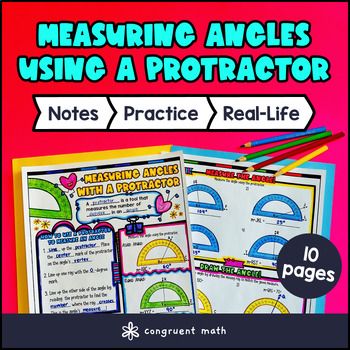Want more ideas and freebies?
Get my free resource library with digital & print activities—plus tips over email.
Join for Free Resources →
$4.25
Ever wondered how to teach measuring angles in an engaging way to your 4th grade students?
In this lesson plan, students will learn about measuring angles with a protractor and their real-life applications. Through artistic, interactive guided notes, checks for understanding, a color-by-code activity, and a maze worksheet, students will gain a comprehensive understanding of measuring acute, obtuse, and right angles.
The lesson culminates with a real-life example that explores how angle measurement is used in everyday situations to solve problems.

$4.25
After this lesson, students will be able to:
Before this lesson, students should be familiar with:
As a hook, ask students if they have ever noticed speed limit signs with angles or seen a clock and wondered how to tell the exact angle between the hands. Why might it be useful to measure these angles in real life? Refer to the real-life math application page at the end of the guided notes as inspiration for this discussion, along with the FAQs below for additional ideas.
Use the first page of the guided notes to introduce the concept of angles and how a protractor measures them. Walk through the definition of an angle, the parts of a protractor (baseline, center hole, degree scale), and how to align it properly with the vertex and one side of the angle. Emphasize the importance of starting from zero and identifying the correct scale to read. Refer to the FAQ below for a detailed walk-through on demonstrating these steps and sample responses to common student questions such as "What if the angle is bigger than 90 degrees?" or "How do I know which line to line up the protractor with?"
Use the second page of the guided notes to solidify the understanding of angle types—acute, right, and obtuse—and how to recognize them by measuring with the protractor. Review the definitions and characteristics of these angle types, then show students how the protractor number readings relate to each category. Guide students through the checks for understanding integrated into the notes, asking questions to confirm their grasp of the concepts. Refer to the FAQ below for strategies to clarify misconceptions, such as confusing the inner and outer scales or mistaking an obtuse angle for a right angle.
If your class has a wide range of proficiency in these introductory steps and angle classifications, consider pulling small groups of students who need extra help for targeted reteaching. Meanwhile, allow students who grasp the concepts quickly to preview the practice exercises in the guided notes or begin sketching and labeling angles to deepen their understanding. This differentiation ensures all students build a strong foundation before moving on.
Have students practice measuring angles using the color by code and maze worksheet activities. Walk around to answer student questions.
Fast finishers can dive into the problem sets provided for extra practice. You can assign it as homework for the remainder of the class.
Bring the class back together, and introduce the concept of how measuring angles with a protractor is used in everyday tasks such as designing buildings, creating artwork, or planning sports plays. Show examples of how architects use precise angle measurements to design safe structures, or how artists incorporate angles into their drawings and sculptures. Discuss with students how knowing acute, obtuse, and right angles can help in real-world problem-solving. Refer to the FAQ for more ideas on how to teach it!
If you’re looking for digital practice for measuring angles, try my Pixel Art activities in Google Sheets. Every answer is automatically checked, and correct answers unlock parts of a mystery picture. It’s incredibly fun, and a powerful tool for differentiation.
Here’s 1 activity to explore:
A protractor is a tool used to measure and draw angles in degrees.
To measure an angle with a protractor, follow these steps:
These are types of angles categorized by their size:
Measuring angles accurately is important because:
4.MD.C.6 is a Common Core State Standard for 4th grade math that involves measuring angles in whole-number degrees using a protractor and solving problems involving angles.
The vertex of an angle is the point where the two sides of the angle meet, often appearing as the corner or the 'tip' of the angle.
Most standard protractors measure angles from 0 to 180 degrees. To measure angles larger than 180 degrees (reflex angles), you can measure the smaller adjacent angle and subtract from 360 degrees.
Measuring angles is useful in many real-life situations, such as:
Get my free resource library with digital & print activities—plus tips over email.
Join for Free Resources →